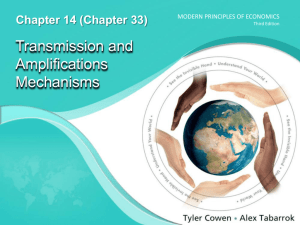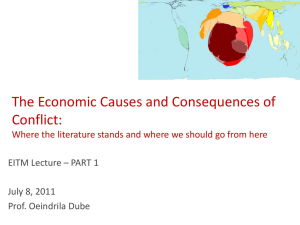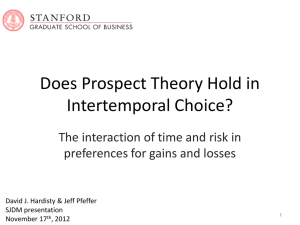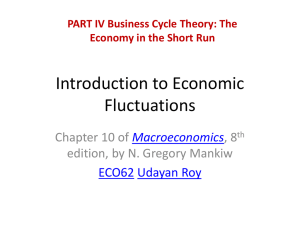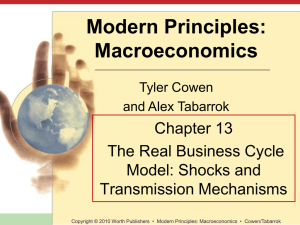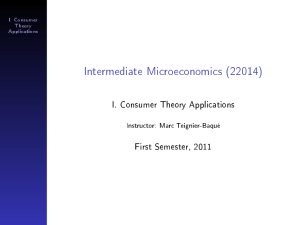PPT
advertisement
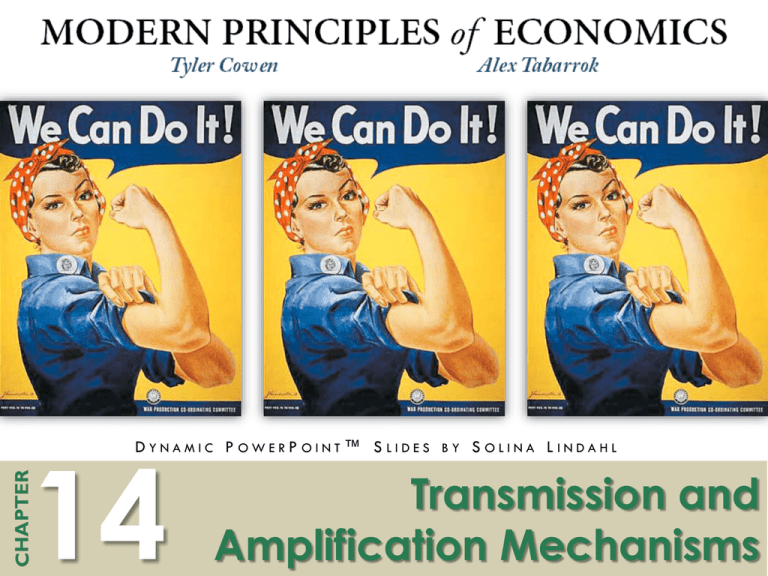
14 CHAPTER DYNAMIC P OWERP OINT™ S LIDES BY S OLINA L INDAHL Transmission and Amplification Mechanisms CHAPTER OUTLINE Intertemporal Substitution Uncertainty and Irreversible Investments Labor Adjustment Costs Time Bunching Collateral Damage For applications, click here To Try it! questions To Video Food for Thought…. Some good blogs and other sites to get the juices flowing: Introduction Shocks to a part of the economy can be amplified across the economy and through time…. Transmission mechanisms are economic forces that can amplify shocks by transmitting them across time and sectors of the economy. BACK TO Transmission Mechanisms Amplify and Spread Shocks Five transmission mechanisms: 1. 2. 3. 4. 5. Intertemporal substitution. Uncertainty and irreversible investments. Labor adjustment costs. Time bunching. Sticky wages and prices. BACK TO Intertemporal Substitution 1. Intertemporal substitution: the allocation of consumption, work, and leisure across time to maximize well-being. People pay attention to opportunity costs: A person or business works less hard when working hard brings the lowest return (and vice versa) High unemployment? College enrollment is up. Recession? People retire early. BACK TO Intertemporal Substitution Farmers work harder when crops are productive (and work is profitable), less when not. People truly “make hay while the sun shines”. BACK TO SEE THE INVISIBLE HAND When do you study? More as it gets closer to a test or equally each day? Most people: closer to the test (when the payoff is greater). 8 Try it! Which of the following cases is an example of intertemporal substitution? a) A person decides to stop being a stay-athome mother and enters the workforce to get extra money for future college expenses. b) A person decides to stop being a stay at home mother and enters the workforce because the economy is booming. c) A person studies continuously throughout the semester for her final exams. d) The United States enters a recession and a To next person loses his job. Try it! SEE THE INVISIBLE HAND Rosie the Riveter: Intertemporal substitution at work during World War II? 10 Intertemporal Substitution Intertemporal Substitution Effect: Intertemporal substitution magnifies economic shocks. When things go a bit bad, the return to work and investing falls; people work and invest less. Also, intertemporal substitution can feed an economic boom and make it more intense. BACK TO Intertemporal Substitution When GDP is growing slower than the trend, the employment to population ratio is also growing slower. The reverse is also true. BACK TO Try it! Which of the following careers is not an example of employment that is characterized by “intertemporal substitution” (i.e., careers in which someone might choose to work more during times when the wage is higher but less when the wage is lower)? a) b) c) d) swimming pool lifeguard in the summer ski-resort employee bankruptcy attorney public worker (ex: government assistant, U.S. mailman/mailwoman) To next Try it! Intertemporal Substitution Inflation rate (p) Solow growth curve An initially small shock….. gets larger with intertemporal substitution Conclusion: intertemporal substitution amplifies the shocks. Negative Average Shock (2%) (3%) Positive Shock (4%) Real GDP growth rate BACK TO Uncertainty and Irreversible Investments 2. Uncertainty and Irreversible Investments Negative shocks increase uncertainty. When investors are uncertain about the future, they often prefer to wait and gather more information before committing. Many investments are irreversible. Example: Once construction on an office building is started, it is hard to tear down the building and redeploy the steel and glass to other economic uses. The more uncertain the world appears, the harder it is for investors to choose where to invest their resources. BACK TO Labor Adjustment Costs 3. Labor Adjustment Costs: the costs of shifting workers from declining sectors of the economy to the growing sectors. Labor adjustments to shocks are difficult and costly. Example: A worker who loses a job may not be willing or able to immediately take a pay cut or move to another state. Result: ↑unemployment and ↓real GDP growth. BACK TO Time Bunching 4. Time Bunching: the tendency of economic activities to be coordinated at common points in time. It pays to coordinate your economic activities with those of others. When do you do garage sales? Saturday morning! BACK TO Time Bunching Bunching also causes shocks to spread through the economy through time. Example: If a negative economic shock arrives and the economy slows down… Many people will be less keen to work. Others will cut back on their work as well. BACK TO Collateral Damage 5. Collateral Damage Collateral: a valuable asset that is pledged to a lender to secure a loan. If the borrower defaults, ownership of the collateral transfers to the lender. Collateral shock: a reduction in the value of collateral. Collateral shocks make borrowing and lending more difficult. BACK TO Collateral Damage When the economy is healthy and firms are profitable, banks are more likely to make new loans (and create more growth) BACK TO Collateral Damage When the economy is strained and firms are less profitable, banks are less likely to make new loans (thus slowing down growth) BACK TO Transmission Mechanisms Amplify and Spread Shocks Transmission Mechanisms: Summary There are five factors that magnify negative economic shocks. Core lesson: a medium-sized negative economic shock is capable of causing a disproportionately large downturn in the economy. Further questions for later chapters: Could the government help offset some of these negative supply shocks? If so, under what conditions? BACK TO Take a look….. Hayek vs. Keynes rap video, by Russ Roberts and John Papola: (7:33 minutes) http://www.youtube.com/watch?v=d0nERTFo-Sk&feature=player_embedded BACK TO Try it! Why have oil shocks become less economically important for the United States in recent years? a) American producers are now more energy efficient. b) Negative oil shocks have been tempered by positive productivity shocks, such as improvements in technology. c) The Federal Reserve has become better at responding to negative oil shocks. d) All of the answers are correct. BACK TO
